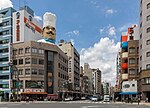The Tokyo National Museum (東京国立博物館, Tōkyō Kokuritsu Hakubutsukan) or TNM is an art museum in Ueno Park in the Taitō ward of Tokyo, Japan. It is one of the four museums operated by the National Institutes for Cultural Heritage (ja:国立文化財機構), is considered the oldest national museum in Japan, is the largest art museum in Japan, and is one of the largest art museums in the world. The museum collects, preserves, and displays a comprehensive collection of artwork and cultural objects from Asia, with a focus on ancient and medieval Japanese art and Asian art along the Silk Road. There is also a large collection of Greco-Buddhist art. The museum holds over 110,000 Cultural Properties, including 89 National Treasures of Japan, 319 Horyuji Treasures, and 644 Important Cultural Properties. In addition, the museum houses over 3000 Cultural Properties deposited by individuals and organizations, including 55 national treasures and 253 important cultural properties (as of March 2019). The museum also conducts research and organizes educational events related to its collection.
The facilities consist of the Honkan, holding the Japanese Gallery; the Heiseikan and Hyokeikan, holding special exhibitions; the Toyokan, holding the Asian Gallery; the Gallery of Horyuji Treasures, holding important relics originally preserved at Nara's Horyu Temple; the Kuroda Memorial Hall, holding a collection of works by Kuroda Seiki; and the Research and Information Center. There are restaurants and shops within the museum's premises, as well as outdoor exhibitions (including the Kuromon) and a garden where visitors can enjoy seasonal views.
TNM stores Japanese cultural properties of modern art, archaeology and ethnology, and cultural properties donated by the imperial family to the state, but more of them owned by the state are further stored in the three National Museum of Modern Art, the National Museum of Japanese History and the Museum of the Imperial Collections. Western art outside the jurisdiction of TNM is housed in the National Museum of Western Art.









